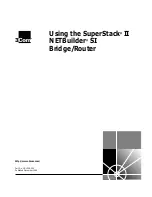
System Management Parameters
Page 228
7950 SR OS Basic System Configuration Guide
Network Time Protocol (NTP)
NTP is the Network Time Protocol defined in RFC 1305,
Network Time Protocol (Version 3)
Specification, Implementation and Analysis
and RFC 5905,
Network Time Protocol Version 4:
Protocol and Algorithms Specification
. It allows for the participating network nodes to keep time
more accurately and more importantly they can maintain time in a more synchronized fashion
between all participating network nodes.
NTP uses stratum levels to define the number of hops from a reference clock. The reference clock
is considered to be a stratum-0 device that is assumed to be accurate with little or no delay.
Stratum-0 servers cannot be used in a network. However, they can be directly connected to devices
that operate as stratum-1 servers. A stratum-1 server is an NTP server with a directly-connected
device that provides Coordinated Universal Time (UTC), such as a GPS or atomic clock.
The higher stratum levels are separated from the stratum-1 server over a network path, thus, a
stratum-2 server receives its time over a network link from a stratum-1 server. A stratum-3 server
receives its time over a network link from a stratum-2 server.
The SR OS will normally operate as a stratum 2 or higher device. It relies on an external stratum 1
server to source accurate time into the network. However, the SR OS also allows for the use of the
local PTP recovered time to be a source into NTP. In this latter case, the local PTP source appears
as a stratum 0 server and the SR OS advertises itself as a stratum 1 server. Activation of the PTP
source into NTP may impact the network NTP topology.
The following NTP elements are supported:
•
Server mode — In this mode, the node advertises the ability to act as a clock source for
other network elements. In this mode, the node will, by default, transmit NTP packets in
NTP version 4 mode.
•
Authentication keys — Increased security support in carrier and other network has been
implemented. Both DES and MD5 authentication are supported as well as multiple keys.
•
Operation in symmetric active mode — This capability requires that NTP be synchronized
with a specific node that is considered more trustworthy or accurate than other nodes
carrying NTP in the system. This mode requires that a specific peer is set.
•
Server and peer addressing using IPv6 — Both external servers and external peers may be
defined using IPv6 or IPv4 addresses. Other features (such as multicast, broadcast) use
IPv4 addressing only.
•
Broadcastor multicastmodes — When operating in these modes, the node will receive or
send using either a multicast (default 224.0.1.1) or a broadcast address. Multicast is
supported on the MGMT port.
•
Alert when NTP server is not available — When none of the configured servers are
reachable on the node, the system reverts to manual timekeeping and issues a critical
alarm. When a server becomes available, a trap is issued indicating that standard operation
Содержание 7950 XRS Series
Страница 8: ...Page 8 7950 SR OS Basic System Configuration Guide List of Tables...
Страница 10: ...Page 10 7950 SR OS Basic System Configuration Guide List of Figures...
Страница 14: ...Preface Page 14 7950 SR OS Basic System Configuration Guide...
Страница 46: ...VI Editor Page 46 7950 SR OS Basic System Configuration Guide...
Страница 76: ...File Management Tasks Page 76 7950 SR OS Basic System Configuration Guide...
Страница 78: ...File Command Reference Page 78 7950 SR OS Basic System Configuration Guide...
Страница 92: ...Basic Command Reference Page 92 7950 SR OS Basic System Configuration Guide show system candidate...
Страница 172: ...Basic CLI Commands Page 172 7950 SR OS Basic System Configuration Guide...
Страница 184: ...Configuration Notes Page 184 7950 SR OS Basic System Configuration Guide...
Страница 214: ...DNS Configuration Commands Page 214 7950 SR OS Basic System Configuration Guide...
Страница 220: ...Show Commands Page 220 7950 SR OS Basic System Configuration Guide...
Страница 494: ...System Commands Page 494 7950 SR OS Basic System Configuration Guide...
Страница 500: ...Standards and Protocols Page 500 Standards and Protocols...
Страница 502: ...Index Page 502 7950 SR OS Basic System Configuration Guide system parameters 252 system time elements 256 timing 294...
















































